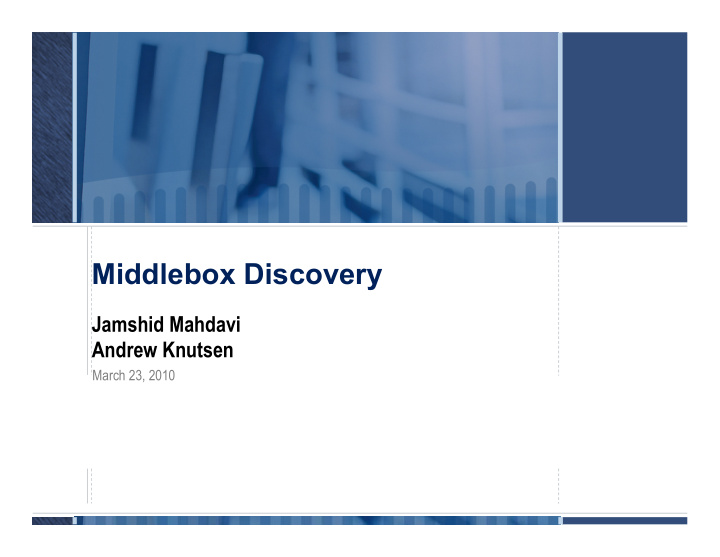



Middlebox Discovery Jamshid Mahdavi Andrew Knutsen March 23, 2010
Talk Outline Middlebox Discovery ID Summary and Status Discussion of Middlebox Needs Other Common Middlebox Issues of Potential Interest to IETF References
ID Summary draft-knutsen-tcpm-middlebox-discovery-03 • Defines a new TCP Option for in-band discovery of middleboxes • Designed from the ground up to: Consume only a single TCP Option Kind for all vendors who need this capability Allow for safe proprietary use as well as future standardized use Includes lessons from years of practical implementation experience • Incorporates numerous good suggestions from tcpm mailing list
ID Status Working Group has chosen not to take this up as a WG item Draft has been submitted for IESG approval
Evolving Internet Connectivity 1980’s: Direct IP to IP connections 1990’s: Firewalls and NATs become prevalent on nearly all paths 2000’s: Increasing use of higher level middleboxes • Proxies (caching, security) • Access points • Acceleration devices • Load balancers • Rate shaping / TCP “enhancing” devices
What about End-to-End Arguments? David D. Clark, Marjory S. Blumenthal, “Rethinking the design of the Internet: The end to end arguments vs. the brave new world”, August 10, 2000. Paper outlines many requirements that we see today
Today’s Drivers Security • Cybercrime and malware are growing problems Performance • Bandwidth savings via advanced compression technologies • Latency savings via protocol optimizations • Improved goodput via TCP optimizations New emerging market for proxies as IPv6 transition appliances
Discovery Example 8
Known Problems There are a few problems we see all the time which the IETF could have an impact on: • TCP ACK storms Application Networking devices often use “fail-to-wire” bridging If fully transparent, when failure happens, ACK storm ensues • Asymmetric routing (or routing changes) Often cited as a key reason transparent intercept is incompatible with Internet architecture But – vendors have numerous proprietary solutions to handle this • Amplification of known issues PMTU black holes Broken support for RFC1323 and other extensions to TCP and IP
References (1/3) Historical references on proxies and Internet architecture: • Chatel, M., “Classical versus Transparent IP Proxies”, RFC1919 (1996). http://datatracker.ietf.org/doc/rfc1919/ • Saltzer, J. H.; Reed, D. P.; Clark, D. D., “End-to-End Arguments in System Design”. (1984). http://web.mit.edu/Saltzer/www/publications/endtoend/endtoend.pdf • Clark, D. D.; Blumenthal, M. S., “Rethinking the design of the Internet: The end to end arguments vs. the brave new world”. (2000). http://cyberlaw.stanford.edu/e2e/papers/TPRC-Clark-Blumenthal.pdf • Clark, D. D.; Sollins, K.; Wroclawski, J.; Faber, T., “Addressing Reality: An Architectural Response to Real-World Demands on the Evolving Internet”. (2003). http://www.isi.edu/newarch/DOCUMENTS/Principles.FDNA03.pdf
References (2/3) Research publications: • Spring, N. T.; Wetherall, D., “A Protocol Independent Technique for Eliminating Redundant Network Traffic”. (2000). http://www.cs.umd.edu/~nspring/papers/sigcomm2000.ps.gz • Li, Q., “A Novel Approach to Manage Asymmetric Traffic Flows for Secure Network Proxies”. (2008). http://www.springerlink.com/content/13n10l6u011530t1/ • Anand, A.; Gupta, A.; Akella, A.; Seshan, S.; Shenker, S., “Packet Caches on Routers: The Implications of Universal Redundant Traffic Elimination”. (2008). http://ccr.sigcomm.org/online/files/p219-anand.pdf • Anand, A.; Sekar, V.; Akella, A., “SmartRE: An Architecture for Coordinated Network-wide Redundancy Elimination”. (2009). http://ccr.sigcomm.org/online/files/p87.pdf 11
References (3/3) Vendor references: • Salchow, K. J., “Load Balancing 101: The Evolution to Application Delivery Controllers”. http://www.f5.com/pdf/white-papers/evolution-adc-wp.pdf • “Technology Primer: Transparent Application Delivery Networks”. http://www.bluecoat.com/doc/5276 • Bartlett, J.; Sevcik, P., “How Network Transparency Affects Application Acceleration Deployment”. http://www.riverbed.com/docs/AnalystReport-NetForecast-Transparency.pdf 12
Recommend
More recommend